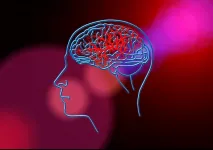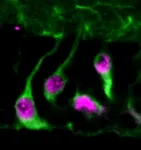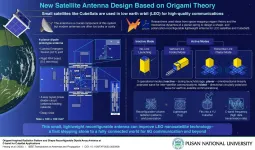(Press-News.org) PHOENIX -- A Mayo Clinic team, led by Rahmi Oklu, M.D., Ph.D., a vascular and interventional radiologist at Mayo Clinic, in collaboration with Samir Mitragotri, Ph.D., of Harvard University, report the development of a new ionic liquid formulation that killed cancer cells and allowed uniform distribution of a chemotherapy drug into liver tumors and other solid tumors in the lab. This discovery could solve a problem that has long plagued drug delivery to tumors and provide new hope to patients with liver cancer awaiting a liver transplant. The preclinical study results are published in Science Translational Medicine.
Dr. Oklu, study author and director of Mayo Clinic's Minimally Invasive Therapeutics Laboratory, says uniform drug delivery to tumors is often riddled with challenges. It's an issue he and the research team are aiming to solve, particularly for patients with liver cancer who are awaiting a transplant.
Dr. Oklu says higher drug doses are often used to encourage drug delivery into the tumor, and these higher doses could lead to significant toxicity. "If the drug cannot penetrate the tumor and remain there, then it cannot do its job," he says.
Current treatment involves ablation, which involves heating or cooling the tumor or infusing radioactive particles into the arteries of the tumor to destroy the cancer cells and keep patients within the criteria for a transplant. "You could do a microwave ablation and basically burn the tumor, but that is often not an option if the tumor is close to the heart or other important structures. And sometimes it is hard to find the blood supply of the tumor to infuse the radioactive particles," Dr. Oklu adds.
Dr. Oklu and his colleagues developed an ionic liquid -- essentially salt in a liquid state -- as an alternative way to deliver drugs into tumors through an ultrasound-guided needle injection. Once injected, the authors say the ionic liquid deposited the chemotherapy drugs uniformly, killing the cancer cells as the liquid engulfed the tumors.
The researchers reported this approach was successful in preclinical studies using freshly resected human tumors in the lab and liver tumors in animal models. In addition, the authors report that the chemotherapy remained in the targeted zone for the length of the 28-day trial.
Whereas drugs often wash away quickly from direct injection into tumors or from standard IV delivery of chemotherapy through the veins of the arm, the ionic liquid, which the authors call a "locally active agent for tumor treatment and eradication," or LATTE, also encouraged immune cell infiltration in the microenvironment of the tumor. This may play a role in achieving immunotherapy in solid tumors. The researchers say this could solve current challenges, especially in hepatocellular carcinoma ? the most common form of liver cancer ? where liver transplant can be curative.
"Ionic liquids are an exceptionally versatile group of materials. In our lab, we have already demonstrated that they have the ability to overcome a variety of biological barriers within the body for delivering drugs. In this study, we demonstrate a novel application of ionic liquids to deliver chemotherapeutic drugs in the liver tumor, says Dr. Mitragotri.
The authors suggest that LATTE may work via diverse methods, and future studies are planned to expand on these preclinical findings. Future efforts might examine additional chemotherapy drugs, effects of immunotherapy agents and effects on overall survival, and involve a detailed analysis of local and bodywide immune implications of this experimental intervention.
INFORMATION:
In addition to Dr. Oklu, Mayo Clinic authors include lead author Hassan Albadawi, M.D.; Zefu Zhang, M.D.; Izzet Altun, M.D., Jingjie Hu, Ph.D., and Leila Jamal. In addition to Dr. Mitragotri, authors from Harvard University are Kelly Ibsen, Ph.D., and Eden Tanner, Ph.D.
This study was funded by the National Institutes of Health. Drs. Oklu, Albadawi and Mitragotri declared that they are inventors on a patent application submitted by Mayo Clinic that covers the composition and application of LATTE. A full list of disclosures is noted in the study.
About Mayo Clinic
Mayo Clinic is a nonprofit organization committed to innovation in clinical practice, education and research, and providing compassion, expertise and answers to everyone who needs healing. Visit the Mayo Clinic News Network for additional Mayo Clinic news and Mayo Clinic Facts for more information about Mayo.
Media contacts:
* Julie Janovsky-Mason, Mayo Clinic Public Affairs, newsbureau@mayo.edu
* Ethan Grove, Mayo Clinic Public Affairs, newsbureau@mayo.edu
Two international studies of a consortium including more than a dozen institutions the world over, including Empa, published today in the journal Nature show levels of CFC-11 emissions, one of many chlorofluorocarbon (CFC) chemicals once widely used in refrigerators and insulating foams, are back on the decline - less than two years after their shock resurgence in the wake of suspected rogue production in eastern China was widely publicized.
"The findings are very welcome news and hopefully mark an end to a disturbing period of apparent regulatory breaches", says Luke Western from the University of Bristol, a ...
Cerebral small vessel disease (SVD) is characterized by damage to the blood vessels and parenchyma in the brain. It presents as a multitude of symptoms, which makes the diagnosis difficult. Matters are complicated further when SVD sets in along with other comorbidities with similar symptoms. Therefore, accurate diagnosis at an early stage of disease progression helps in defining better prognosis and management strategies for patients with cerebral SVD.
A team of researchers from the United Kingdom set out to review more than 10,000 studies on clinical diagnosis, risk factors, progression, and intervention ...
Experts have spent decades warning us about the rising rates of childhood obesity, which has become an epidemic among recent generations in many places around the world, including Spain. The transition from the traditional Mediterranean diet to the consumption of processed foods with low nutritional value is a key contributor, with child-targeted advertising also partly to blame. According to the Breakfast Food Advertisements in Mediterranean Countries: Products' Sugar Content in Adverts from 2015 to 2019 report produced by UOC Faculty of Information and Communication Sciences professor and researcher, Mireia Montaña, the majority of breakfast products ...
In recent years, active, self-propelled particles have received growing interest amongst the scientific community. Examples of active particles and their systems are numerous and very diverse, ranging from bacterium films to flocks of birds or human crowds. These systems can demonstrate unusual behavior, which is challenging to understand or model.
To this end, large-scale models of active particles were being scrutinised by experts at Leicester, in order to understand basic principles underlying active particle dynamics and apply them in a scenario of an evacuation strategy for customers in crowded place. Unexpectedly, the 'super-particles' milling in a circular motion were stumbled upon ...
There's a reason that ideas--even erroneous ones--catch fire on social media or in popular culture: groupthink.
New research co-authored by Berkeley Haas Asst. Prof. Douglas Guilbeault shows that large groups of people all tend to think alike, and also illustrates how easily people's opinions can be swayed by social media--even by artificial users known as bots.
In a series of experiments, published in the journal Nature Communications, Guilbeault and co-authors Damon Centola of the University of Pennsylvania and Andrea Baronchelli of City University London created an online game that asked numerous people to identify ...
Just as beneficial microbes in the human gut can be affected by antibiotics, diet interventions and other disturbances, the microbiomes of other animals can also be upset. In a rare study published this week, Andrea Jani, a researcher with the University of Hawai'i at Mānoa School of Ocean and Earth Science and Technology (SOEST), determined the skin microbiome of an endangered frog was altered when the frogs were infected by a specific fungus, and it didn't recover to its initial state even when the frog was cured of the infection.
All animals host symbiotic microbes--many ...
WASHINGTON--Chinese people are more likely to face high blood pressure and other health risks as a result of higher body mass index (BMI) and waist circumference than people from other racial and ethnic groups, according to a new study published in the Endocrine Society's END ...
SINGAPORE, 10 February 2021 - Researchers studying an enzyme in fruit fly larvae have found that it plays an important role in waking up brain stem cells from their dormant 'quiescent' state, enabling them to proliferate and generate new neurons. Published in the journal EMBO Reports, the study by Duke-NUS Medical School, Singapore, could help clarify how some neurodevelopmental disorders such as autism and microcephaly occur.
Quiescent neural stem cells in the fruit fly larval brainPr-set7 is an enzyme involved in maintaining genome stability, DNA repair and cell cycle regulation, as well as ...
Modern telecommunication systems rely on satellites to relay signals across the globe quickly and reliably, enabling users to send messages across the world in an instant, watch live television, or - more recently - hold conference calls with global partners right from the kitchen table!
Communications satellites use high-frequency radio waves to transmit data, with antennas acting as a two-way interface, converting electric current provided by the transmitter into radio waves, and vice versa when paired with a receiver. Antennas are therefore vital pieces of equipment, without which satellites and ground receivers would be practically useless. However, despite advances in modern satellite design and performance, antenna technology remains a limiting factor for ...
With the advent of 5G communication technology and its integration with AI, we are looking at the dawn of a new era in which people, machines, objects, and devices are connected like never before. This smart era will be characterized by smart facilities and services such as self-driving cars, smart UAVs, and intelligent healthcare. This will be the aftermath of a technological revolution.
But the flip side of such technological revolution is that AI itself can be used to attack or threaten the security of 5G-enabled systems which, in turn, can greatly compromise their reliability. It is, therefore, imperative to investigate such potential security threats and explore countermeasures before a smart world is realized.
In a recent study published ...





